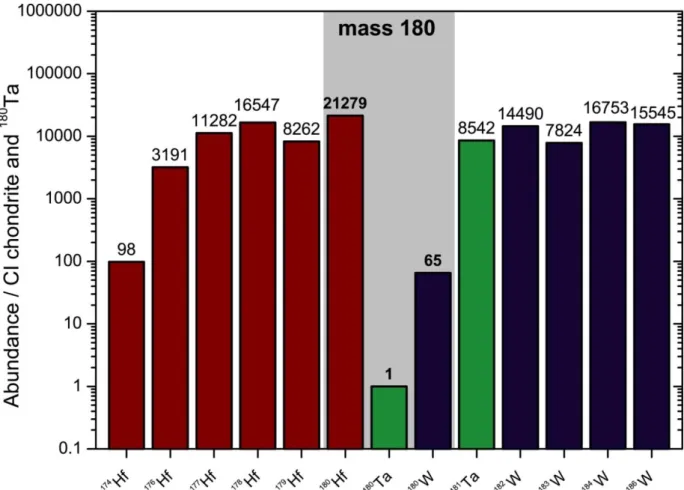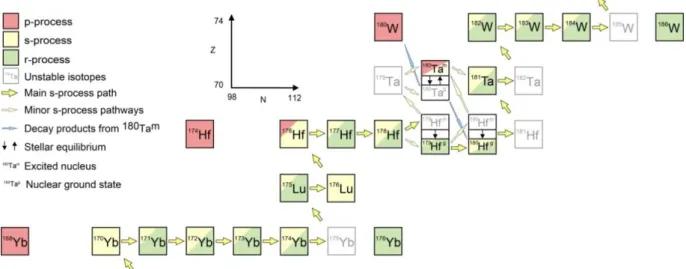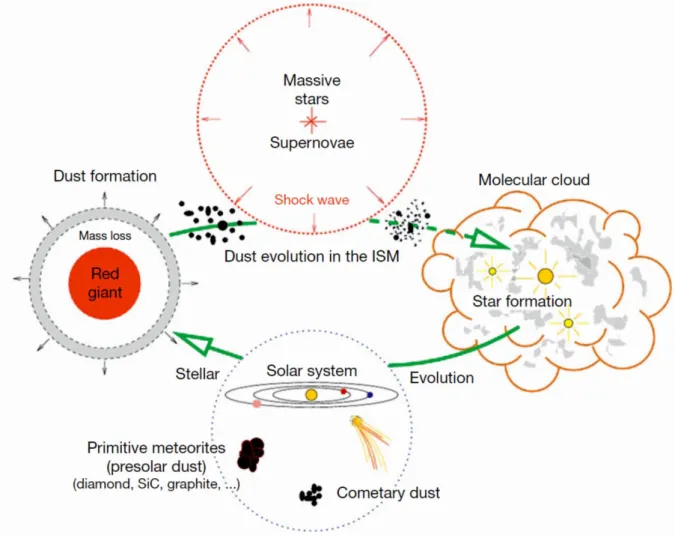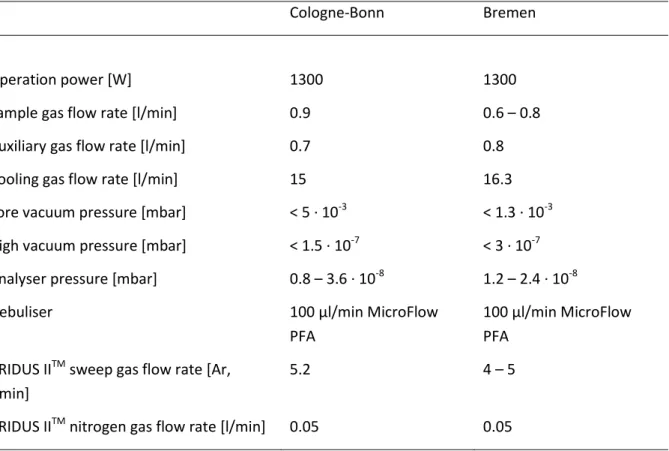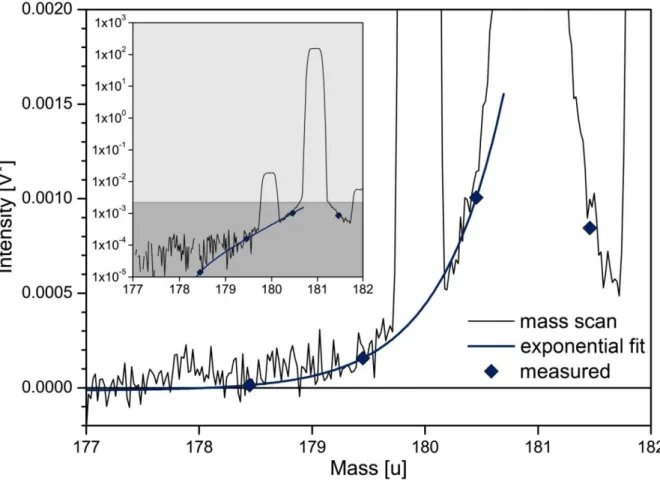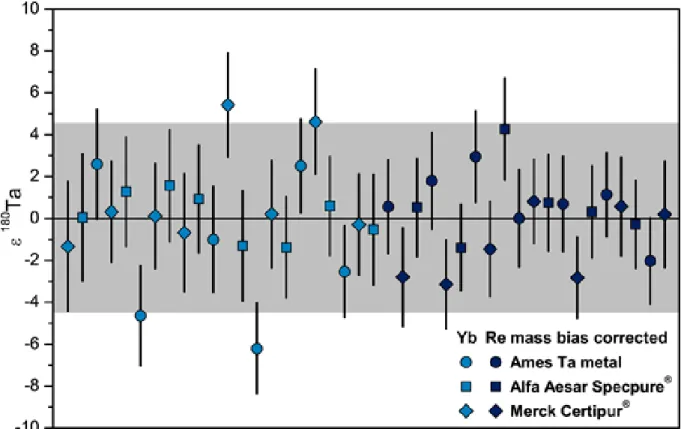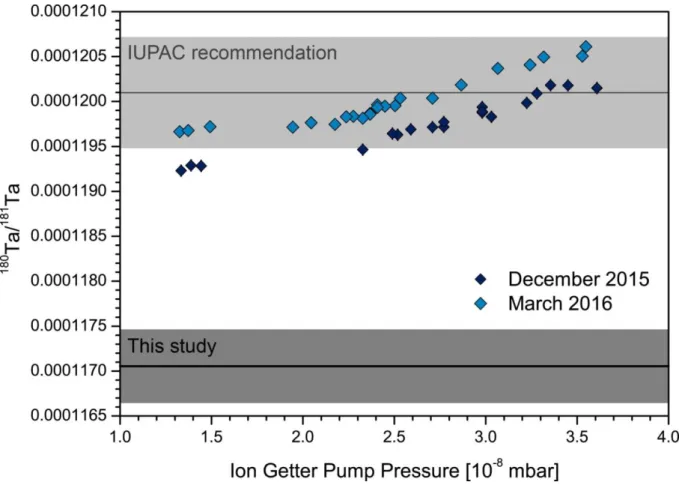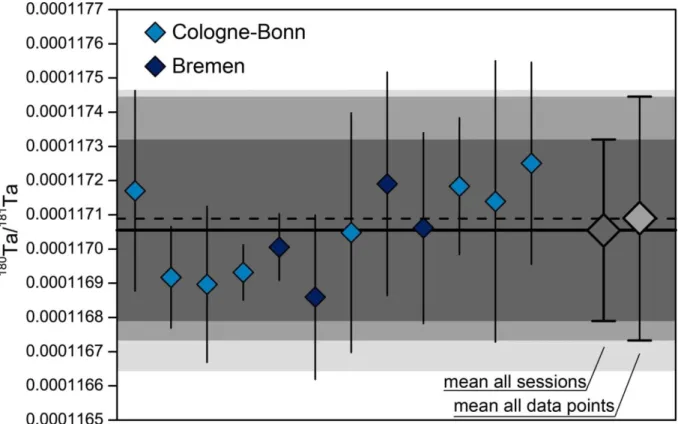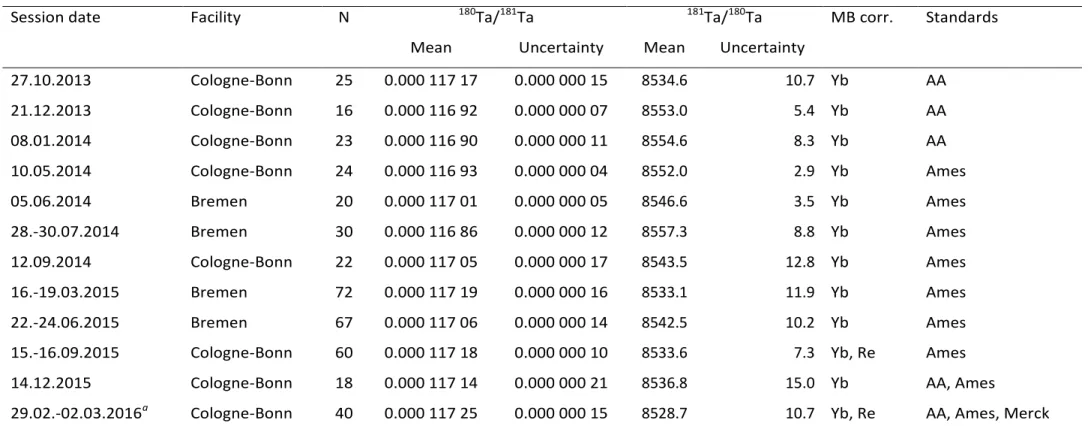The Tantalum isotope inventory of terrestrial and early solar system materials
Inaugural-Dissertation zur
Erlangung des Doktorgrades
der Mathematisch-Naturwissenschaftlichen Fakultät der Universität zu Köln
vorgelegt von Markus Pfeifer
aus Koblenz
Köln, 2017
Berichterstatter Prof. Dr. Carsten Münker (Gutachter)
PD Dr. Dominik Hezel
Tag der mündlichen Prüfung 18.01.2017
Abstract
Tantalum is the rarest stable element in the solar system and consists of two stable isotopes with a huge difference in abundances (
180Ta = ~0.012% and
181Ta = ~99.988%), making
180Ta the rarest stable nuclide in the solar system. Tantalum isotopes are produced together with other heavy isotopes during stellar nucleosynthesis in stars at the end of their life, in red giants as well as in supernova explosions. While
181Ta has been produced by the rapid and slow neutron capture processes (r- and s-process), the rare isotope
180Ta is bred by the branched s- process and by the special neutrino-process, which is only significant for one further heavy nuclide,
138La. Tantalum-180 is the only observationally stable nuclide in an excited nuclear state. Because of this property, nuclear astrophysics has long searched for viable production mechanism to explain the abundance of
180
Ta in the solar system. As the earliest materials of the solar system are known to carry nucleosynthetic anomalies as fingerprints of their stellar origin, astrophysical models of Ta nucleosynthesis might be tested in meteorites. The low abundance of
180Ta relative to isotopes of similar mass including
181Ta make Ta isotope compositions to a sensitive tracer of ingrowth from nuclear reactions in neighboring elements like Hf in the early solar system.
In modern geochemistry, Ta is a key trace element, belonging to the group of high field strength elements (HFSE, i.e., Zr, Nb, Hf, Ta). Due to analytical difficulties related to the low abundance of
180
Ta, the absolute isotope composition of tantalum is one of the least constrained of any naturally occurring elements and possible natural variations in
180Ta/
181Ta have so far not been investigated.
The unusual production and physical properties of
180Ta might render Ta isotope compositions useful for tracing nucleosynthetic input or irradiation in the early solar system. Substantial analytical development was required in order to evaluate possible variations of Ta isotope compositions in solar system materials and whether natural Ta stable isotope variations exist on Earth.
Following the introduction to Ta isotope geo- and cosmochemistry in Chapter I, Chapter II
presents the analytical protocol to obtain high-precision Ta isotopes data and introduces an
improved value for the absolute Ta isotope ratio. Using a Neptune
TMmulticollector-inductively
coupled plasma-mass spectrometer (MC-ICP-MS) and different resistors in the Faraday cup amplifier
feedback loops (a 10
10Ω for
181Ta; 10
12or newly developed 10
13Ω resistors for
180Ta and Hf
interference monitor isotopes) now allows relative analyses of
180Ta/
181Ta with an intermediate
precision (external reproducibility) of ca. ±4 ε (ε refers to one part in 10,000) using 25 to 100 ng Ta
and thus even for sample sizes available from meteorites (e.g., 1 g of sample required). The 10
13Ω
amplifier resistors proved to be of paramount importance for high-precision Ta isotope ratio
measurements of low amounts of material. Tailing effects from the large
181Ta beam have previously
been underestimated. A thorough assessment of this effect revealed a tailing contribution of ~2.5 %
on the currently recommended IUPAC ratio. Potential systematic biases in the mass discrimination correction are assumed being of minor importance compared to an uncertainty of ~0.4 % achieved for the estimate of the “true”
180Ta/
181Ta ratio. This work proposes a revised
180Ta/
181Ta isotope ratio of 0.00011705(41), equivalent to
181Ta/
180Ta = 8543(30), yielding isotope abundances of 0.011704(41)
% for
180Ta and 99.988296(41) % for
181Ta, and an absolute atomic weight for tantalum of 180.9478787(38) u (all uncertainties with k = 2, corresponds to 2 S.D.).
As a tool to trace mass fluxes of Ta and in Earth and solar system objects, chapter III presents an improved chemical separation protocol for silicate samples and assesses the challenges in mass spectrometry to resolve possible deviations from the natural
180Ta/
181Ta ratio. Especially the isobaric interferences from abundant
180Hf and potential molecular interferences on the rare isotope
180Ta and interference monitor isotopes are carefully evaluated. At present, no terrestrial sample or bulk meteorite exhibits Ta isotope compositions that are resolvable from the Ta standard solution, which therefore represents the bulk silicate Earth Ta composition. Likewise, there is no evidence for Ta isotope fractionation during ore forming processes or during progressive Ta depletion in upper mantle melting processes. No isotope effects due to early solar system processes like irradiation or redox related elemental fractionation were observed in bulk meteorites. However, Ta isotope variations may be present within meteorite components as discussed in the following chapter.
In chapter IV, Ta isotope measurements were performed on Calcium-Aluminum-rich inclusions
(CAIs) the earliest materials formed in our solar system. A diversity of isotope anomalies has been
found in CAIs for a range of elements, which is attributed to excesses and depletions of distinct
nucleosynthetic components synthesized at different stellar sites. So far, simple models failed to
explain the complexity in nucleosynthetic anomalies observed in CAIs. In an approach to identify
processes acting on CAIs, and to search for exotic nucleosynthetic anomalies from distinct stellar
sources, this work combines high-precision high field strength element (HFSE) concentration and Hf,
Ta, and W isotope measurements on 6 CAIs. The HFSE patterns obtained are largely condensation
controlled but exhibit differences to thermodynamic predictions in elemental abundances of U and
the pairs Mo-W and Nb-Ta, which may be related to inaccuracies in the canonical condensation
model. Tantalum isotopes show resolvable anomalies in two of the analyzed CAIs, with
180Ta being
enriched relative to
181Ta. If this reflects nucleosynthetic heterogeneity, it is not correlated with p-, s-,
or r-process anomalies in neighboring Hf and W. Alternatively, the Ta isotope anomalies may express
excess in neutrino process derived nuclides. In combination with recent findings of excesses in
50V
and
138La and with
50V,
138La, and
180Ta being odd-odd-isotopes occupying interstitial sites in the chart
Kurzzusammenfassung
Tantal ist das seltenste, stabile Element des Sonnensystems und besteht aus zwei stabilen Isotopen mit einem riesigen Unterschied der Isotopenhäufigkeiten (
180Ta = ~0.012 % und
181Ta =
~99.988 %), was
180Ta zum seltensten stabilen Nuklid des Sonnensystems macht. Tantalisotope werden zusammen mit anderen schweren Isotopen während der stellaren Nukleosynthese in Sternen am Ende ihres Lebens, sprich Roten Riesen und Supernovae, gebildet. Während
181Ta durch den schnellen und langsamen Neutroneneinfangprozess produziert wird (s- und r-Prozess), wird das seltene Isotope
180Ta durch den verzweigten s-Prozess und durch den Neutrino-Prozess erbrütet, der sonst nur für ein weiteres schweres Nuklid bedeutend ist (
138La). Tantal-180 ist das einzige bekannte stabile Nuklid in einem angeregten Kernzustand. Auf Grund dieser Eigenschaft wurde in der nuklearen Astrophysik lange nach eine geeigneten Produktionsmechanismus gesucht um die solare Häufigkeit von
180Ta zu erklären. Da die frühesten Materialien des Sonnensystems dafür bekannt sind nukleosynthetische Anomalien als Zeugnis ihren stellaren Ursprungs zu besitzen, können astrophysikalische Modelle an Meteoriten verifiziert werden. Die geringe Häufigkeit von
180Ta im Verhältnis zu Isotopen ähnlicher Masse, inklusive
181Ta, macht die Ta-Isotopenzusammensetzung zu einem empfindlichen Tracer für den Nachweis von nuklearen Reaktionen im frühen Sonnensystem an Nachbarelementen wie Hf.
In der modernen Geochemie ist Ta ein Schlüsselelement und gehört der geochemischen Gruppe der stark geladen Ionen an (HFSE, bestehend aus Zr, Nb, Hf, Ta). Auf Grund von analytischen Schwierigkeiten in Zusammenhang mit der geringen Häufigkeit von
180Ta, ist das Isotopenverhältnis von Tantal eines der am wenigsten bekannten unter den natürlich vorkommenden Elementen, weswegen natürliche Variationen bisher nie untersucht wurden. Durch die ungewöhnliche Produktion und die physikalischen Eigenschaften von
180Ta könnten sich Ta- Isotopenzusammensetzungen als nützlich erweisen um nukleosynthetischen Eintrag oder Bestrahlung im frühen Sonnensystem nachzuweisen. Substantielle analytische Verbesserungen waren nötig um mögliche Variationen in Materialen des Sonnensystems nachzuweisen und die Frage nach natürlichen Variationen auf der Erde zu klären.
Nach der Einführung zur Geo- und Kosmochemie der Ta-Isotope in Kapitel I, wird in Kapitel II das analytische Protokoll für hochpräzise Ta Isotopenmessungen vorgestellt. Damit wurde ein verbessertes absolutes Ta-Isotopenverhältnis bestimmt. Mit Hilfe eines Neptune
TMMultikollektor- Induktiv gekoppelten Plasma Massenspektrometers (MC-ICP-MS) und verschiedenen Verstärkern angeschlossen an die Faradaydetektoren (ein 10
10Ω Widerstand für
181Ta, 10
12oder neu entwickelte 10
13Ω Widerstände für
180Ta und den Hf Interferenzmonitor) ist es nun möglich relative Analysen von
180
Ta/
181Ta mit einer externen Reproduzierbarkeit von ca. ±4 ε (ε bedeutet ein Teil in 10 000) an 25
bis 100 ng Ta durchzuführen, genug für geringe Probenmengen wie Meteoriten (z.B. 1 g). Die 10
13Ω Verstärker haben sich als unerlässlich für hochpräzise Ta-Isotopenverhältnismessungen an geringen Probenmengen herausgestellt. Tailingeffekte des
181Ta Ionenstrahls wurden in der Vergangenheit unterschätzt. Eine sorgfältige Untersuchung des Effekts hat einen Anteil von ca. 2,5% auf den derzeit akzeptierten IUPAC-Wert offenbart. Mögliche systematische Fehler in der Massendiskriminierungskorrektur sind in Anbetracht der erreichten Unsicherheit von ca. 0,4% auf den „wahren“
180Ta/
181Ta-Wert vernachlässigbar. Diese Arbeit stellt ein überarbeitetes Isotopenverhältnis von
180Ta/
181Ta = 0.00011705(41) vor, gleichbedeutend mit
181Ta/
180Ta = 8543(30).
Dies ergibt Isotopenhäufigkeiten von 0.011704(41) % für
180Ta und 99.988296(41) % für
181Ta, und ein absolutes Atomgewicht für Tantal von 180.9478787(38) u (alle Unsicherheiten mit k = 2, entspricht 2 Standardabweichungen).
Als ein Werkzeug um Masseflüsse von Ta in der Erde und in Objekten Sonnensystem zu verfolgen, wird in Kapitel III ein verbessertes chemisches Abtrennungsverfahren für silikatische Proben vorgestellt und die Herausforderungen evaluiert um Variationen im
180Ta/
181Ta Verhältnis aufzulösen. Besonders die isobare Interferenz des häufigen
180Hf und mögliche molekulare Interferenzen auf dem seltenen
180Ta und den Interferenzmonitoren werden untersucht. Bisher sind keine Ta Isotopenzusammensetzungen in terrestrischen Proben oder Gesamtgesteinsmeteorite von der Ta Standardlösung auflösbar, wodurch diese die Zusammensetzung der silikatischen Gesamterde entspricht. Ebenso gibt es keine Hinweise auf Isotopenfraktionierung während Erzbildung oder allmählicher Ta Elementverarmung des oberen Erdmantels durch Schmelzprozesse. Bestrahlung oder Redox-bedingte Elementfraktionierung im frühen Sonnensystem kann durch Ta Isotopenmessungen in Gesamtmeteoriten ausgeschlossen werden. Dennoch könnten Ta Isotopenvariationen in Komponenten von Meteoriten zu finden sein, wie im nächsten Kapitel diskutiert.
In Kapitel IV wurden Ta Isotopenmessungen an Kalzium-Aluminium-reichen Einschlüssen (CAIs) durchgeführt, den frühesten Materialen geformt in unserem Sonnensystem. Diverse Isotopenanomalien wurden in einer Bandbreite an Elementen in CAIs gefunden, die auf Anreicherung und Verarmung von distinkten nukleosynthetischen Anomalien, gebildet in verschiedenen stellaren Umgebungen, zurückgeführt wird. Bisher waren einfache Modelle nicht in der Lage die Komplexität von nukleosynthetischen Anomalien in CAIs zu erklären. In einem Versuch Prozesse, die auf CAIs wirken, zu identifizieren und um exotische nukleosynthetische Anomalien zu suchen, wurden kombinierten HFSE-Konzentrations- und Hf, Ta, und W Isotopenmessungen an 6 CAIs durchgeführt.
Die gemessenen HFSE- Muster sind größtenteils kondensationskontrolliert aber zeigen in den
wobei
180Ta relativ zu
181Ta angereichert ist. Falls dies eine nukleosynthetische Anomalie
wiederspiegelt, ist diese nicht mit p-, s-, or r-Prozessanomalien in angrenzenden Elementen Hf oder
W korreliert. Als Alternative könnten die Ta Isotopenanomalien Ausdruck eines Überschusses an
Neutrino-Prozess abstammenden Materials sein. In Kombination mit Entdeckungen von
Überschüssen an
50V und
138La und der Tatsache, dass
50V,
138La und
180Ta alle ungerade-ungerade
Isotope sind, die auf einem Zwischenplatz in der Nuklidkarte sitzen, wird vorgeschlagen das
Protonenbestrahlung von der proto-Sonne möglicherweise die Isotopenzusammensetzung gewisser
Elemente in CAIs beeinflusst haben könnte.
Table of contents
Chapter I
Introduction ... 3
1.1 The element Tantalum – chemistry and physics ... 3
1.2 Nucleosynthesis of heavy elements with emphasis on Tantalum isotopes ... 5
1.3 The building blocks of our Solar System... 8
1.4 Geochemistry of Tantalum ... 9
1.5 Chapter overview ... 10
Chapter II Tantalum isotope ratio measurements and isotope abundances determined by MC-ICP-MS using amplifiers equipped with 10
10, 10
12and 10
13Ohm resistors ... 12
2.1 INTRODUCTION ... 12
2.2 EXPERIMENTAL ... 14
2.2.1 General set-up and data evaluation ... 14
2.2.2 Correction of instrumental mass discrimination ... 18
2.2.3 Abundance sensitivity in
180Ta/
181Ta measurements... 20
2.2.4 Terminology related to uncertainties ... 22
2.3 RESULTS AND DISCUSSION ... 23
2.3.1 Intermediate precision and homogeneity of Ta standard solutions ... 23
2.3.2 Low ion beam measurements using 10
13Ω resistor Faraday cup amplifiers ... 24
2.3.3 Effect of tailing on measured Ta ratios ... 27
2.3.4 The absolute isotope composition of tantalum ... 30
2.4 CONCLUSIONS ... 37
Chapter III High precision Tantalum isotope ratio measurements of terrestrial samples and meteorites: evaluation of potential Ta isotope fractionation during Earth’s formation and differentiation ... 39
3.1 INTRODUCTION ... 39
3.2 METHODS ... 42
3.2.1 Sample description ... 42
3.2.2 Reagents and sample digestion ... 43
3.2.3 Elemental separation ... 44
Table of contents
3.4 DISCUSSION ... 56
3.4.1 Potential of stable isotope fractionation in igneous systems ... 56
3.4.2 Constraints from Ta isotopes on processes in the early solar system ... 61
3.5 CONCLUSIONS ... 64
Chapter IV Repeated processing and irradiation of Ca-Al-rich inclusions: evidence from combined high field strength element concentrations and Hf, Ta, and W isotope measurements ... 66
4.1 INTRODUCTION ... 66
4.2 METHODS ... 68
4.2.1 Sample description and preparation ... 68
4.2.2 Digestion and chemical separation ... 69
4.2.3 Data acquisition ... 71
4.3 RESULTS ... 73
4.3.1 Mineralogy and classification of CAIs ... 73
4.3.2 Rare earth and high-field strength element isotope dilution concentration determinations of CAIs ... 76
4.3.3 Ta and Hf isotope ratio data ... 79
4.4 DISCUSSION ... 82
4.4.1 Processes leading to elemental fractionation of HFSE in CAIs ... 82
4.4.2 Quality assessment of Ta isotope measurements and potential stable Ta isotope fractionation ... 87
4.4.3 Nucleosynthetic Ta components in meteorites ... 89
4.4.4 Irradiation of CAI-forming region from nascent sun ... 92
4.4.5 Approaching the processes responsible for isotope anomalies in the early Solar System 93 4.5 CONCLUSIONS ... 95
5 References ... 96
6 Danksagung ... 109
Appendix A: Backscattered electron images of CAIs ... 111
Appendix B: EMP mineral analyses on CAIs ... 114
Appendix C: Trace element concentrations of CAIs ... 117
Erklärung ... 118
Lebenslauf ... Fehler! Textmarke nicht definiert.
Chapter I
Introduction
1.1 The element Tantalum – chemistry and physics
Tantalum was discovered as a chemical element in 1802. The Swedish chemist Anders Gustaf Ekeberg isolated an unknown oxide from an ore found in south-east Finland (Ekeberg 1802). The same oxide was separated from yttria, a substance containing new chemical elements extracted from a mineral deposit in Sweden near the town of Ytterby, in which the heavy rare earth elements were discovered as well. Another oxide was separated from a mineral from Colombia by Charles Hatchett in 1801 (Griffith and Morris, 2003). Both oxides from Scandinavia and Colombia were first believed to contain the same element until Heinrich Rose proved their difference in 1844. For the heavier element the name Tantalum from Ekeberg was kept, while the lighter one was called Niobium (Holleman and Wiberg, 2007). The name Tantalum derives from Greek mythology. Tantalos was a king who was allowed to dine with the godfather Zeus. To challenge the Gods, he sacrificed his son and served him on the table. This did not go unaware by the Gods who punished Tantalus to eternal pain in Tartarus, the deepest part of the Underworld. Ekeberg chose the Tantalum after the proverbial “torments of Tantalus” as he was unable to dissolve the newly discovered oxide with strong acids. Niobium, which was identified as an offspring of the Ta oxide, was named after the daughter of Tantalus, Niobe (Rose 1844).
In the periodic table, Tantalum belongs to the Vanadium group and has the atomic number
73. Its chemical properties are closely related to those of Niobium, which leads to a virtually identical
behavior of both elements in geological systems. This is why both elements are considered as
geochemical twins. The valence state of Nb and Ta ions in Earth is 5+ and both elements have very
similar ionic radii of 0.68Å and 0.69Å (Shannon, 1976). The metals are very refractory, which is also
valid for the metal oxides condensing early from a hot vaporized solar nebula at the beginning of the
solar system (Lodders, 2003). The elemental Ta abundance of 0.015µg/g in the solar System is
constrained from the CI carbonaceous chondrites, which are the most primitive meteorites and
I. Introduction
assumed to be to 0.043µg/g (Palme and O'Neill, 2014), while the crust is enriched to 0.7µg/g (Rudnick and Gao, 2014).
Tantalum consists of only two observationally stable isotopes,
180Ta and
181Ta. What makes Ta exceptional to other elements is the large spread in isotope abundances of 99.9883 % for
181Ta and only 0.0117 % for the minor isotope
180Ta (this thesis). Furthermore,
180Ta is the only stable isotope with a nucleus in an excited state. Interestingly, its ground state decays with a half-time of 8.1 h to
180
Hf and
180W, making the higher stability of the excited nucleus a prerequisite for its presence in nature. The large differences in isotope ratios precluded the discovery of
180Ta until 1955 (White et al., 1955). Since then, the official atomic weight has only been updated twice by the International Union on Pure and Applied Chemistry due to new isotope abundance measurements (http://www.ciaaw.org/tantalum.htm, accessed 25.11.2016).
The extreme difference in isotope abundances is very challenging for high-precision isotope
ratio measurements. The low abundance of
180Ta and the prediction of only minor isotope
fractionation in Earth made it unlikely to find resolvable differences in natural materials. Apart from
the technical aspect, Ta needs to be efficiently separated from other elements in terrestrial and
extraterrestrial samples, especially from Hf and W that cause isobaric interferences in mass
spectrometry. Figure 1.1 illustrates the need for an efficient chemical separation protocol and the
difficulties in obtaining accurate isotope ratios with abundances of isotopes in the same mass area in
primitive meteorites. Particularly
180Hf has almost the same mass as
180Ta and is more than 20,000
times more abundant. Thus, only a small number of scientific publications concentrated on the
determination of the Ta isotope ratio in pure standard materials, while different terrestrial and
extraterrestrial materials have never been analyzed for their isotope composition.
Fig. 1.1
Isotope abundances of elements Hf, Ta, and W in the solar system relative to
180Ta. Tantalum-180 is orders of magnitude rarer than neighboring isotopes and suffers from isobaric interferences from
180W and particularly
180Hf during mass spectrometry. Note that even the small isotopes of Hf and W are by the factors of 65 and 98 more abundant (
174Hf and
180W abundances from Peters et al. 2015). Element abundances are taken from Palme et al. (2014), abundances of other Hf and W isotope from the recommended IUPAC values Meija et
al., 2016, and Ta isotope abundances from this study.1.2 Nucleosynthesis of heavy elements with emphasis on Tantalum isotopes
The pioneering study about the synthesis of elements in stars was published by Burbidge,
Burbidge, Fowler, and Hoyle (B
2FH) in 1957. Following developments and achievements have been
reviewed recently (e.g., Meyer, 1994; Wallerstein et al., 1997; Sneden et al., 2008). The elements
until the mass region of iron are produced during stellar fusion, where hydrogen is progressively
transformed into heavier elements under the release of energy. Most of the nuclides beyond the Fe
peak are essentially produced by two processes in massive stars: slow neutron capture (s-process)
I. Introduction
isotope and undergo beta-minus decay to convert to the next, proton-richer element (e.g., Herwig, 2005; Bisterzo et al., 2011). This way, seed nuclei from the Fe peak gradually climb up the chart of nuclides through the valley of stability until they reach Bismuth (Fig. 1.2), which is easily modeled and explains the abundance of about 50% of the material in our solar system (Arlandini et al., 1999;
Bisterzo et al., 2014). The newly synthesized nuclides are brought to the stellar surface during dredge-up phases initiated by thermal pulses, and are then dispersed into the interstellar medium by massive stellar winds (e.g., Herwig, 2005). The r-process is bound to explosive environments.
Compared to the s-process, neutron densities are orders of magnitude higher to overcome beta- decay unstable isotopes and produce the neutron-rich nuclides within seconds. After the explosion event, the nuclides close to the neutron-drop line subsequently decay back towards the valley of stability. In contrast to the well-defined and modelled s-process, the site of the r-process is not unequivocally identified, yet. Most work considers core-collapse supernovae type II (cc SNe II) as the most probable site for universal r-process (e.g., Woosley et al., 2002; Tissot et al., 2016), but there is evidence for decoupling of light and heavy r-process nuclides (Wasserburg et al., 1996; Thielemann et al., 2011; Tsujimoto and Shigeyama, 2014).
However, neutron capture fails to explain the p-rich nuclides to the left of the valley of
stability and proton capture is rendered difficult by the Coulomb barrier. Altogether, these isotopes
require a distinct production process (Burbidge et al., 1957; Arnould, 1976). P-process nuclides are
often one or two orders less abundant than the s- and r-process isotopes. However, this term is
somewhat misleading as the different p-nuclides are produced by different nuclear reactions at
different stellar sites (Rayet et al., 1995; Arnould and Goriely, 2003; Rauscher et al., 2013). The main
site is assumed to be cc SNe II, where gamma-rays induce photo-disintegration reactions on existing
s- and r-nuclides, by expelling neutrons from the nucleus (γ-process). The lighter p-process nuclides
are under-produced by the γ-process relative to the solar system abundances and require an
additional site of formation. Thermonuclear explosions of white dwarfs (supernovae type Ia) are able
to produce the lighter p-nuclides by the rapid proton capture process (Travaglio et al., 2011).
Fig. 1.2
Excerpt from the chart of nuclides illustrating the nucleosynthesis of isotopes in the mass region around Ta. The color code represents the approximate nucleosynthetic contributions. Unstable nuclides and short-lived isomeric states are greyed out. The thick yellow arrows mark the main s-process path up the chart of nuclides with the smaller ones indicating branching. The green r-process nuclides are produced from beta- minus decay of progenitor nuclides initially far to the right of the chart after the r-process event. The red p-rich nuclides cannot be produced by neutron capture reactions. Reactions involving isomeric nuclei are important for the s-process nucleosynthesis around Ta. The ground state and the excited state of
180Ta are present in equilibrium under stellar conditions, whereas the ground state decays away with a half-time of 8.1 hours, as indicated by the blue arrows. Modified after Vockenhuber et al. (2007).
Tantalum-180 is about two orders of magnitudes rarer than the directly adjacent p-process
isotopes
174Hf and
180W, indicating its unusual production mechanism (see Fig. 1.2). It holds a special
position in nucleosynthetic models as it is both produced by branching of the main s-process path
and by the special neutrino-process (ν-process; Arnould and Goriely, 2003). Intermediate mass AGB
stars favor branching for the production of
180Ta, where an excited state of
179Hf is populated that can
decay to
179Ta, which then captures a neutron to produce
180Ta (Fig. 1.2; Beer and Ward, 1981; Yokoi
and Takahashi, 1983). A long standing problem in nuclear astrophysics was the survival of the
isomeric state of
180Ta as the ground state decays too fast to survive the way out of the star (e.g.,
Belic et al., 1999; Käppeler et al., 2004). Newest model are able to calculate the fraction of
180Ta
surviving stellar conditions and could constrain the s-process
180Ta abundance of the solar system to
about 80% (Mohr et al., 2007; Bisterzo et al., 2014). The ν-process is related to cc SNe II, where the
formation of the neutron star delivers the high neutrino fluence necessary to receive nuclear
reactions (Woosley et al., 1990; Heger et al., 2005). Neutrinos interact only rarely with normal matter
which is why the ν-process is only important for two nuclides heavier than iron,
138La and
180Ta.
I. Introduction
1.3 The building blocks of our solar system
The isotopic composition of elements in our solar system represents a blend from all nucleosynthetic processes. The nucleosynthetic products from ancient stars were ejected into the interstellar medium, mixed, evaporated and condensed, and eventually formed molecular clouds giving birth to new stars like our Sun (Hester and Desch 2005). Figure 1.3 illustrates the building blocks and processes acting on material prior to assembly of the solar system. Evidence of the inheritance of interstellar material in the solar system was found in presolar grains in primitive meteorites (Anders and Zinner, 1993). It is however open, if and to what extent the solar nebula was influenced by later input or inner disk processing to alter the isotope compositions of the different elements.
Fig. 1.3
The solar system put in context of the galactic chemical evolution. Red giants and supernovae produce
new nuclides through their different nucleosynthetic reaction networks and pollute the interstellar medium
(ISM) with freshly synthesized nuclides. Being part of the ISM, the dust is further processed by high-energetic
particles, eventually forming molecular clouds. In those star factories, stellar systems like our solar system can
form. Comets and primitive meteorites carry the witnesses of those processes with presolar grains. The Figure
is taken from Jones (2004).
Refractory materials in meteorites, so called Ca-Al-rich inclusions (CAIs), bear evidence for different components in the early solar system. Nucleosynthetic anomalies in heavier elements are known in CAIs since the 1970s (McCulloch and Wasserburg, 1978a; McCulloch and Wasserburg, 1978b) and could be related to distinct nucleosynthetic processes (see Dauphas and Schauble, 2016 and references therein for recent review). Several theories exist about the origin of these isotope variations. To some extent, they might be an expression of an initial heterogeneity in the solar nebula during formation of earliest condensates (e.g., Kööp et al., 2016). A further model invokes the addition of material through a nearby supernova explosion or stellar winds by a massive star in the star-forming cluster from which our Sun has originated from, which might have triggered the collapse of the molecular cloud to form the solar system (Cameron and Truran, 1977; Gounelle and Meynet, 2012). A last model assumes initial physical homogeneity of presolar carrier phases in the molecular cloud, which then got processed in the early solar system to different extents, causing formation of isotopically distinct reservoirs that are necessary to explain large scale differences in meteorite parent bodies (Dauphas et al., 2002; Trinquier et al., 2009). In addition to nucleosynthetic anomalies, the presence of extinct
10Be in CAIs hints to spallation reaction induced from proton-irradiation from the active proto-Sun (McKeegan, 2000). Presently, the influence of irradiation on heavier isotopes is debated (Gounelle et al., 2001; Desch et al., 2010), but odd-odd nuclides
50V and
138La were found to exhibit positive isotope anomalies in CAIs (Shen and Lee, 2003; Sossi et al. 2016).
Other heavy elements like Zr, Hf and W are known to exhibit nucleosynthetic anomalies in the earliest solar system (Burkhardt et al., 2008; Sprung et al., 2010; Akram et al., 2013; Kruijer et al., 2014; Peters et al., 2016). In this context, it is likely to assume variations in Ta isotopes as well, which might be a valuable tool to trace exact nucleosynthetic contributions in connection with Hf and W isotope data. Furthermore, Ta isotopes might be a sensitive tracer of early irradiation in the solar system as
180Ta would show significant ingrowth due to its low abundance.
1.4 Geochemistry of Tantalum
The localities of the first recognized occurrences of Ta ores in Sweden and Finland are prime
examples for the geochemical affinity of Ta. Both ores stem from pegmatites and represent late-
stage evolved granitic systems, where incompatible elements are concentrated in the last magmatic
phase. This contrasts to meteorites, where the primitive chondrites have refractory element contents
representing the solar abundance with Ta being the rarest element in the solar system. Earth,
I. Introduction
As a high-field strength element (HFSE), Ta is highly incompatible in most rocks and always tends to enter into a silicate melt. This results in a progressive depletion of the Earth’s mantle in Ta and a concentration of Ta in the crust over geological time. The high charge combined with their small size renders Ta ions unable to fit into crystal lattices of most silicate minerals. Small concentrations of Ta can be incorporated in amphiboles or accessory oxide minerals in less evolved magmas like basalts or andesite (e.g., Brenan et al., 1994; Ionov and Hofmann, 1995). Tantalum generally becomes enriched in the most fractionated melts and crystallizes its own minerals. The mineralization of Tantalum cannot be discussed without mentioning Niobium as both elements are geochemical twins and are typically incorporated in the same minerals. Therefore, Ta and Nb form solid solution series in their own group of minerals. Typical Tantalum ore minerals are columbite [(Mn,Fe)(Nb,Ta)
2O
6] and tantalite [(Mn,Fe)(Ta,Nb)
2O
6] series, which are colloquially known as Coltan (Dill, 2010). Another important ore mineral is the microlite group [(Na,Ca)
2Ta
2O
6(O,OH,F)], which exhibits a solid solution with the Nb-rich pyrochlore group (Dill, 2010). Apart from the aforementioned minerals associated with granites and pegmatites, carbonatites are highly enriched in Nb and Ta (Chakhmouradian, 2006).
The elemental ratio between Nb and Ta is widely used as a tracer for geochemical processes acting at scales of magmatic systems, oceans, or planets (e.g., Jochum et al., 1986; Green and Pearson, 1987; Barth et al., 2000; Münker et al., 2003; Weyer et al., 2003; Schmidt et al., 2014).
Offsets from the chondritic ratio of ca. 19.9 (Münker et al., 2003) are the result of small geochemical fractionation between the two elements. However, the magnitude of fractionation is normally limited due to their extremely similar geochemical characteristics. Stable isotope fractionation of Ta in combination with characteristic Nb and Ta elemental concentrations might indicate distinct geological or cosmochemical processes being in operation. Measurements of rocks with various Nb/Ta ratios from different settings should provide endmember-constraints on potential Ta isotope fractionation on Earth and may offer new possibilities for application in geoscientific problems.
1.5 Chapter overview
This thesis gives an extensive overview on the isotopic inventory of Ta in materials from
Earth and the early solar system. Chapter II focusses on the development of the mass spectrometric
method and discusses the advantage of newly developed 10
13Ω resistor Faraday detector amplifiers
for high-precision measurements of small sample sizes as necessary for Ta isotope measurements in
meteorites. Furthermore, after thorough assessment of systematic errors in Ta isotope
measurements, the presently accepted natural Ta isotope abundances in standard materials are re-
evaluated.
Chapter III introduces the chemical purification protocol essential for accurate and precise Ta isotope measurements of natural materials and challenges in Ta isotope measurements of natural samples are discussed. Progressive depletion and enrichment in Earth reservoirs, differences in complexation of Ta in melts or low-temperature elemental re-distribution could give rise to stable isotope fractionation. A suite of rocks from a range of geodynamic settings are therefore analyzed for their Ta isotope compositions. No Ta isotope variations were found on Earth. Furthermore, measurements of Ta isotopes in bulk meteorites revealed no larger scale isotope variability in the solar system. This information is necessary to interpret isotope anomalies in meteorite components.
In Chapter IV, Ta isotopes are tested as a new tool in cosmochemistry. Combined HFSE
concentration and Hf-Ta-W isotope analyses are performed to elucidate the processing of CAIs in the
early solar system. Tantalum isotope anomalies were identified in two CAIs. The differences in Ta
isotopes are discussed in context with recent isotope data and astrophysical models. Nucleosynthetic
isotope anomalies or early irradiation are inferred as possible reason of Ta isotope variations in early
solar system materials.
Chapter II
Chapter II
Tantalum isotope ratio measurements and isotope abundances determined by MC-ICP-MS using amplifiers
equipped with 10 10 , 10 12 and 10 13 Ohm resistors
2.1 INTRODUCTION
Tantalum is the rarest chemical element in the solar system. It consists of two isotopes with the major isotope
181Ta accounting for 99.98799(8) % of its molar abundance, according to current IUPAC recommendations (Meija et al., 2016). In contrast, the reported relative abundance of
180Ta equals only 0.01201(8) % (Meija et al., 2016), making
180Ta the rarest stable nuclide in the solar system, which is why
180Ta was not discovered until 1955 (White et al., 1955). Furthermore,
180Ta is the only observationally stable isotope present as an excited nuclear isomer. In its ground state,
180Ta decays to
180Hf and
180W with a half-life of only 8 hours (e.g., de Laeter and Bukilic, 2005; Hult et al., 2006). The extreme difference in isotope abundances of a factor of more than 8000 makes the precise and accurate determination of Ta isotope ratios by mass spectrometry challenging. Using a multi-collector ICP-MS system (MC-ICP-MS), we partially overcome the large difference in isotope abundances by collecting a large ion beam for
181Ta in a Faraday cup with 10
10Ω resistor in the amplifier feedback loop (up to 5 · 10
-9A, equivalent to 500 V if common 10
11Ω resistors would be applied), while collecting the low abundance isotope
180Ta and isobaric interference monitors with Faraday amplifiers with high-Ohm resistors.
The isotope composition of Ta is of particular interest because it may vary in extraterrestrial
materials. For many elements technical advances in mass spectrometry over the past 15 years (e.g.,
Wieser and Schwieters, 2005) made it possible to resolve small isotope anomalies at the sub-per mil
level in solar system materials relative to Earth, e.g., Zr (Schönbächler et al., 2003), Mo (Dauphas et
al., 2002; Yin et al., 2002), Ru (Dauphas et al., 2004), Ba (Hidaka et al., 2003), Nd (Boyet and Carlson,
2005; Andreasen and Sharma 2006) or Sm (Andreasen and Sharma 2006). These so-called
nucleosynthetic isotope anomalies give testimony to the early evolution of the solar system, such as
thermal processing of presolar grains from other stars (e.g., Huss et al., 2003; Trinquier et al., 2009) or later injection of material from nearby star explosions into the nascent solar system (Cameron and Truran, 1977). Additionally, the Ta isotope compositions of natural samples may show variations due to mass-dependent, nuclear volume dependent or kinetic stable isotope fractionation during geological processes. Hence, sufficiently precise measurements protocols for Ta isotopes in order to identify such effects are required.
Previous Ta isotope analyses by MC-ICP-MS and thermal ionisation mass spectrometry (TIMS) employed Faraday collectors with 10
11Ω resistors in the amplifier feedback loop. The electronic noise contribution from this conventional setup can be reduced by about a factor of three by the use of recently developed amplifiers with 10
12Ω resistors (Makishima and Nakamura, 2010; Koornneef et al. 2013). Amplifiers with 10
12Ω resistors are used in TIMS and MC-ICP-MS for three main purposes:
1) Measurement of small sample sizes (Makishima and Nakamura, 2010; Liu and Pearson, 2014;
Sarkar et al., 2015), 2) precise monitoring of interfering elements (Schiller et al., 2012; Schulz et al., 2013; Peters et al., 2014; Peters et al., 2014) and 3) combined application with 10
10, 10
11, and 10
12Ω resistors to account for largely different ion beam intensities of one element (Wielandt and Bizzarro, 2011; Naumenko et al., 2013; Peters et al., 2015). The advent of newly developed amplifiers equipped with 10
13Ω resistors further reduced physical limitations by, in theory, increasing the signal-to-noise ratio by a factor of √100 compared to an amplifier equipped with a 10
11Ω resistor (Koornneef et al., 2014, Koornneef et al., 2015, Klaver et al., 2016). The precision of a 4 · 10
-14A ion current (equivalent to 4 mV with 10
11Ω resistors) on
143Nd was shown to improve by factors of 2 and 4 compared to 10
12and 10
11Ω amplifiers, respectively (Koornneef et al., 2014). At count rates above 2 · 10
4cps (= 0.32 mV), 10
13Ω resistors even proved to be superior to secondary electron multipliers (Koornneef et al., 2014). Collectively, these technical improvements set the stage to search for small differences in Ta isotope ratios in geological and meteoritic materials.
So far, only Kimura et al. (2016) documented the applicability of amplifiers equipped with
10
13Ω resistors in MC-ICP-MS. Here, we also compare the performance of 10
13Ω resistors with that
of 10
12amplifiers. We extend the application of 10
13Ω resistors to precise monitoring of strongly
interfering elements and to measuring very low abundance isotopes that limit the precision of
isotope ratio measurements. A protocol is presented here for high-precision Ta isotope ratio
measurements, with an emphasis on the application to extraterrestrial samples of limited size. This
protocol furthermore allows a re-evaluation of the terrestrial
180Ta/
181Ta isotope ratio that is
recommended by IUPAC (0.0001201(6); de Laeter and Bukilic, 2005) and by Weyer et al.
Chapter II
(Thirlwall and Anczkiewicz 2004). The two studies that previously presented Ta isotope data discuss this abundance sensitivity effect. While de Laeter and Bukilic (2005) neglected tailing effects, Weyer et al. (2002) identified abundance sensitivity as the limiting factor for accurate Ta isotope ratio measurements. The latter study consequently suggested a lowermost value for
180Ta/
181Ta = 0.000115. In the present study, we evaluate the effect of varying pressure at the high-vacuum end of the instrument on the abundance sensitivity and measured isotope ratios. We then present an offline tailing correction, suggesting that the tailing of
181Ta on
180Ta has been underestimated in the past. A significantly lower
180Ta/
181Ta isotope ratio and, therefore, a lower absolute isotope abundance of
180
Ta are proposed.
2.2 EXPERIMENTAL
Measurements were conducted on a Thermo Scientific Neptune
TMMC-ICP-MS instrument (upgraded with a Plus interface) at facilities at the joint Cologne-Bonn MC-ICP-MS laboratory, Germany, and on a Thermo Scientific Neptune Plus
TMat Bremen, Germany, from February 2013 to March 2016. The data were obtained in 12 individual sessions consisting of 22 measurement sequences.
2.2.1 General set-up and data evaluation
Traditionally, many users of mass spectrometers discuss ion beam intensities in voltages
measured across the resistor, rather than ion currents. However, measured voltages change with the
resistor value according to Ohm’s law. In order to compare the signal intensities we report voltages
as V*, meaning the signal intensity as if a 10
11Ω resistor were in use, which is in the same manner as
the instrument software reports ion beam signal intensities. Both instruments were operated with a
Jet interface (Jet sampler cone, X-skimmer cone, and On-Tool booster pump) and a Cetac ARIDUS II
TMdesolvating system. The PFA nebulisers provide uptake rates of ca. 100 µl/min, using 0.56 M
HNO
3/0.24 M HF as measurement solution. Typical operating conditions are given in Table 2.1 for the
instruments at Cologne-Bonn and Bremen with a single analysis comprising of 120 cycles of 4.2 s
integration time or 60 cycles of 8.4 s integration time to account for settling delays of the high-Ohm
resistors.
Table 2.1 Typical MC-ICP-MS instrument operating conditions during Ta isotope ratio measurements
Cologne-Bonn Bremen
Operation power [W] 1300 1300
Sample gas flow rate [l/min] 0.9 0.6 – 0.8
Auxiliary gas flow rate [l/min] 0.7 0.8
Cooling gas flow rate [l/min] 15 16.3
Fore vacuum pressure [mbar] < 5 · 10
-3< 1.3 · 10
-3High vacuum pressure [mbar] < 1.5 · 10
-7< 3 · 10
-7Analyser pressure [mbar] 0.8 – 3.6 · 10
-81.2 – 2.4 · 10
-8Nebuliser 100 µl/min MicroFlow
PFA
100 µl/min MicroFlow PFA
ARIDUS II
TMsweep gas flow rate [Ar, l/min]
5.2 4 – 5
ARIDUS II
TMnitrogen gas flow rate [l/min] 0.05 0.05
Tantalum consumption for one measurement at Bremen was ~25 ng leading to a 4.5 · 10
-10A ion current on
181Ta for a 30 ng/g standard solution (corresponds to 45V*). At Cologne-Bonn, ion currents of around 2 · 10
-9A were achieved for a 100 ng/g solutions, consuming ~90 ng Ta. This translates to 1600–1900 V* per µg/g Ta at both instruments. Mass bias correction was typically performed externally using doped Yb. For this purpose, the Alfa Aesar Specpure® plasma Yb standard solution (LOT 71-064667L) was admixed to the Ta solutions at a concentration of ca. 8 ng/g, resulting in an ion current of ca. 6 · 10
-11A on the largest isotope
174Yb (isotope abundance of ~32 %). External mass bias correction based on Re isotopes (Alfa Aesar Specpure® LOT 71-071361B) was also tested (chapter 2.2.2). The Ta standard solution that was predominantly used during this project had previously been prepared from AMES Ta-metal at Münster (Weyer et al., 2002). Additionally, the Alfa Aesar Specpure® Ta plasma standard solution (LOT 15024103) and Merck Certipur® Ta ICP standard solution (LOT HC56783956) were measured for comparison and to test for potential stable isotope fractionation during the industrial Ta purification process.
Gain calibration for the Faraday amplifier was performed using the software operated
standard procedure where a 33.3 fA reference current (equal to 3.33 V*) is consecutively applied to
Chapter II
Nd solution (here: Merck Certipur® ICP standard solution LOT HC077146), first with the electronically calibrated 10
11Ω amplifiers with ca. 140 mV* on
148Nd using a 10 ng/g solution in wet plasma. The amplifiers connected to the Faraday cups that collect
145Nd,
148Nd, and
150Nd were then switched to 10
13Ω amplifiers, while keeping the
144Nd ion beam in a Faraday cup connected to a gain calibrated 10
11Ω amplifier. The tuning parameters were kept unchanged during the 20 minutes baseline measurement and the subsequent repeated measurement of the Nd standard. The gains for the 10
13Ω amplifiers were calculated from the results from the two measurements and were manually entered in the executive table of the instrument software. Hence, no assumptions about true isotope ratios and accuracy of mass discrimination laws needed to be made during this gain calibration procedure, as the 10
13resistor amplifier gains are calculated from the ratios in comparison to the same isotope ratios previously measured with gain corrected 10
11Ω resistors. The three isotopes of Nd measured here are of comparable abundance and make Nd an ideal element for cross calibration of up to three 10
13Ω amplifiers. Kimura et al. (2016) applied an inter-calibration approach by cycling the attached amplifiers to each Nd isotope and calculate the gains on the amplifiers with a solver function in Excel (Kimura et al., 2016). Our approach could be simplified as the normalising isotope
144
Nd was always measured with a previously gain corrected 10
11Ω resistor. Earlier work applied measurements of secondary standards to monitor the stability of the gain calibration. This is not necessary, as the amplifiers proved to be stable enough on timescales relevant for typical lengths of MC-ICP-MS analytical sessions (Koornneef et al., 2014).
The typical repeatability (corresponds to internal precision in the geochemical literature) of the Nd measurements with 10
13Ω amplifiers is better than 80 ppm (2 S.E.) for
148Nd/
144Nd. Repeated measurements using this protocol yield an intermediate precision (corresponds to external reproducibility in geochemical publications) of better than 82 ppm for
148Nd/
144Nd (2 S.D., n = 10).
The electronic cross calibration of the standard 10
11Ω amplifiers using a 33.3 fA reference current is typically reproducible to better than 16 ppm (2 S.D.), which results in a combined uncertainty of the cross calibration of ca. 1 ε (2 S.D.), in accord with previously reported gain precision for 10
13Ω amplifiers (Klaver et al., 2016). This uncertainty cancels out for measurements relative to a standard.
The baseline was measured prior to each measurement session with a deflected ion beam
over 1000 cycles of 1.05 s each. Baseline measurements were always performed more than 30
minutes after the gain calibration to allow settling of our early model 10
12Ω resistors towards
baseline levels. Low intensity
180Ta and the critical interference monitor
178Hf were collected in
Faraday cups attached to amplifiers with 10
12Ω resistors at Cologne-Bonn and to amplifiers with 10
13Ω resistors at Bremen (Table 2.2). In order to improve the counting statistics and the signal to noise
ratio for the low-abundance isotope
180Ta, large signals had to be measured for
181Ta, using an
amplifier with a 10
10Ω resistor at Cologne-Bonn. Additional ion beams were collected with amplifiers
with 10
11Ω resistors (Table 2.2). Typical signal voltages on
181Ta were 45 V* at Bremen and 150 - 200 V* at Cologne-Bonn to achieve sufficient precision with ca. 5 and 20 mV* on
180Ta, respectively.
Table 2.2
Collector set-ups and assigned amplifiers with indicated resistors. The element used for mass bias correction and the resulting amplifier configuration is given for each facility. Elemental isobaric interferences are shown in brackets. Resistors other than 10
11Ω are marked in bold.
Configuration L4 L3 L2 L1 C H1 H2 H3 H4
Yb-based mass bias correction
171
Yb
172Yb
173Yb
174Yb (
174Hf)
178
Hf
179Hf
180Ta (
180Hf) (
180W)
181
Ta
183W
Amplifier Cologne-Bonn 10
1110
1110
1110
1110
1210
1110
1210
1010
11Amplifier Bremen 10
1110
1110
1110
1110
1310
1210
1310
1110
12Re-based mass bias correction
178
Hf
179Hf
180Ta (
180Hf) (
180W)
181
Ta
183W
184W (
184Os)
185
Re
187Re (
187Os)
189
Os
Amplifier Cologne Bonn 10
1210
1110
1210
1010
1110
1110
1110
1110
11For comparison, all data were processed offline and online. Instrumental mass bias was
corrected externally based on the measured isotope composition of Yb between masses 171 and
174, using the exponential law (also known as Russell’s law; Russell et al., 1978) and the Yb ratios
recommended by Albalat et al., (2012) The latter data agreed better with our mass discrimination
corrected data than the IUPAC recommended values from de Laeter and Bukilic (de Laeter and
Bukilic, 2006). All Ta isotope data are reported relative either to
173Yb/
171Yb = 1.12489 (Yb-based
mass bias correction (Albalat et al., 2012) or
187Re/
185Re = 1.67394 (Re-based mass bias correction
(Meija et al., 2016). Elemental isobaric interferences were corrected based on
180Hf/
178Hf = 1.2863
and
180W/
183W = 0.008304, which represent our long-term measured values (Peters et al., 2015). In
particular the very large isobaric interference from
180Hf (relative abundance 35.08 %) on
180Ta
required careful correction, even in the case of the purest standard solutions. In terms of mass
fractionation, elements of similar mass such as Yb, Hf, Ta, W, and Re transmitted through the mass
spectrometer will be biased by very similar extents. Therefore, for the correction of
180Hf and
180W
Chapter II
or
187Re/
185Re. Regular tests with Hf-doped Ta standard solutions confirmed the robustness of the interference correction over time. The measured
178Hf/
181Ta of the pure standard solutions were <1 · 10
-6, i.e., below the threshold of
178Hf/
181Ta = 8 · 10
-6at which the correction starts to introduce significant biases. The minor interference of
174Hf (~0.16 %) on
174Yb does not result in significant uncertainty propagation into the external mass bias correction, nor does it affect the absolute mass- bias corrected Ta isotope ratios, because Hf is virtually absent in the Ta standard solutions. The same applies for the interference of
187Os on
187Re if doped Re is used for external normalisation.
Measured data are partly presented as the deviation from a reference standard using the epsilon notation (parts per ten thousand):
𝜀
180𝑇𝑎 = [
(180𝑇𝑎⁄181𝑇𝑎)𝑖𝑛𝑑𝑖𝑣𝑖𝑑𝑢𝑎𝑙 𝑠𝑡𝑎𝑛𝑑𝑎𝑟𝑑(180𝑇𝑎⁄181𝑇𝑎)𝑟𝑒𝑓𝑒𝑟𝑒𝑛𝑐𝑒 𝑠𝑡𝑎𝑛𝑑𝑎𝑟𝑑
